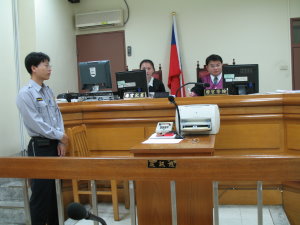Introduction to The Prosecutorial System
- Publication Date:
- Last updated:2022-02-22
- View count:4641
 I. The Establishment of Prosecutorial System in Taiwan
I. The Establishment of Prosecutorial System in Taiwan
The prosecutorial system in Taiwan was established based on the model of German law. However, since the late 1990s, some procedures in the US criminal law, for instance, the cross-examination procedure, have been incorporated into Taiwan’s criminal law, aiming to enhance the protection of the defendants. Since then, the prosecutor not only performs the investigation and enforces the decisions of the court, but also conducts the public prosecution in the court.
Taiwan's prosecutorial system, like those in most of the countries, is designed as a three-tier system. The highest authority is Supreme Prosecutors Office , which is headed by the Prosecutor General. The second tier comprises of six High Prosecutors Offices, which are charged with the supervision of the District Prosecutors Office. The lowest level has twenty District Prosecutors Offices, responsible for the local criminal cases in their own jurisdictional territories.
The Prosecutor General is to supervise all prosecutors at different levels of the whole nation, whereas the Chief Prosecutors of the High Prosecutors Offices and the District Prosecutors Offices are responsible for the business of their respective offices. Administrative affairs, such as the appointment of the Chief Prosecutors of the High Prosecutors Office and the District Prosecutors Office, are determined by the Ministry of Justice.
II. The Jurisdictional Territory of the Prosecutors Office
The titles and the jurisdictional territories of these prosecutors’ offices are as follows:

III. The Function of Prosecutors
1. Investigation
Prosecutors shall conduct the investigation, whenever a criminal case arises. If a prosecutor, based on complaint, knowledge, or voluntary surrender, or any other reason, suspects the crime having been committed, he/she shall immediately commence an investigation of the crime and the relevant evidence. After the completion of the investigation, the prosecutor shall make one of the following decisions: transfer of jurisdiction, prosecution, non-prosecution, or deferred prosecution.
A. transfer of jurisdiction
If a prosecutor considers that a case is not within his/her jurisdiction, he/she shall immediately notify or refer the case to the competent prosecutors office (or military prosecutors office) or the competent juvenile court.
B. prosecution
If evidence obtained by the prosecutor as a result of investigation is sufficient to show that the suspect has committed the crime, the prosecutor shall instigate public prosecution and prepare the filing of an indictment with the court.
C. non-prosecution
A prosecutor shall make a disposition of non-prosecution in some circumstances where, for instance, the suspicion of a crime is insufficient, the suspect is dead, or the case involved is one that may be initiated only upon complaint or request, or such complaint or request has been withdrawn or the period within which a complaint may be filed has expired.
In addition, if the prosecutor considers it appropriate not to prosecute a case involving minor offences, he/she can make a disposition of non-prosecution.
Within the seven days after the receipt of a written disposition of non-prosecution, the complainant can appeal, through the District Prosecutors Office, to the High Prosecutors Office for reconsideration. If the application for reconsideration is well grounded, the original prosecutor shall continue his/her investigation or the High Prosecutors Office shall refer the case back to the District Prosecutors Office.
D. deferred prosecution
Prosecutors may defer the prosecution when he/she considers it proper and the crimes committed do not involve one of the offences for which the death penalty or life sentence might be imposed or for which the minimum principal punishment may be the imprisonment for more than three years. While prosecutors make such decision, defendants might be ordered to follow prosecutors’ constructions. For instance, he might be ordered to make an apology to the victims or contribute money to some appropriate organizations.
2. Public Prosecution in the Court
If the prosecutor makes the decision of prosecution, he/she shall conduct public prosecution against the defendants in the court. For example, he/she shall appear in court on the day of the hearing, state the essential points of the prosecution before the court, cross-examine the defendants and witnesses, and make an appeal immediately if the judgment by the court is considered improper.
3. Enforcement of Court Decisions
In addition to the investigation and the public prosecution in the court, prosecutors are mandated to supervise the enforcement of court decisions.
4. Assisting in Private Prosecution
According to the law, a person who is injured by the commission of crime may initiate a private prosecution. On the day of hearing, prosecutors can render his/her assistance by expressing opinions if he/she thinks the case is seriously concerned with the interest of the State or society.
5. Taking Charge of Private Prosecution
If a complainant, after initiating his/her private prosecution, is found dead or unable to proceed his/her private prosecution, the court shall notify a prosecutor to take charge of prosecuting the case after it finds no one may resume the prosecution.
6. Performing other functions prescribed by the laws other than the Criminal Code
Prosecutors are authorized to request the court to dissolve a jurist person whose purpose or behavior is found contrary to public order or good morals. In addition, the Chief Prosecutor of the District Prosecutors Office is empowered to directly supervise the local bar association. Any lawyer who is found to violate the Lawyers’ Law should be referred by the Chief Prosecutor to the Attorney Disciplinary Committee for disciplinary action.

